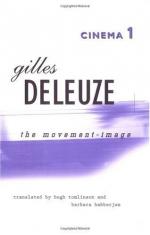
|
| Name: _________________________ | Period: ___________________ |
This test consists of 15 multiple choice questions and 5 short answer questions.
Multiple Choice Questions
1. What is Eisenstein's close-up style?
(a) Subjective.
(b) Objective.
(c) Affective.
(d) Active.
2. In addition to movement, a track shot incorporates which of the following?
(a) Duration.
(b) Unity.
(c) Equilibrium.
(d) Cutting.
3. Which of the following describes a soft camera focus?
(a) Sensory factor.
(b) Active factor.
(c) Modified factor.
(d) Affective factor.
4. What is the second role of the face, according to Deleuze?
(a) Shadowing.
(b) Firsting.
(c) Socializing.
(d) Cinemizing.
5. What does out-of-field refer to?
(a) Equilibrium.
(b) Montage.
(c) Beyond the frame.
(d) Geometrical frame.
6. Who discovered composition of movement as images with organic unity?
(a) Gance.
(b) Griffith.
(c) Eisenstein.
(d) Deleuze.
7. The view of a participating character is which of the following images?
(a) Cogito factor.
(b) Affective factor.
(c) Active factor.
(d) Sensory factor.
8. Modified, restored images are assumed to be which of the following?
(a) Objective.
(b) Affective.
(c) Subjective.
(d) Perceptive.
9. In second level shots, what is movement determined by?
(a) Cutting.
(b) Fixed cameras.
(c) Exceptional situations.
(d) Mitry.
10. When was Deleuze's first film book published?
(a) 1971.
(b) 1994.
(c) 1983.
(d) 1956.
11. Bergson says that what element is not light?
(a) Movement.
(b) Image.
(c) Matter.
(d) Consciousness.
12. What shows the change from one view to another?
(a) Exceptional shots.
(b) Montage.
(c) First level shot.
(d) Second level shot.
13. Which of the following is described as the determination of the whole?
(a) Expressionism.
(b) Dialect.
(c) Quantitative elements.
(d) Montage.
14. The view of someone external to the set is described as which of the following?
(a) Objective.
(b) Direct.
(c) Subjective.
(d) Indirect.
15. What do only affection-images refer to?
(a) Individuality.
(b) Firstness.
(c) Secondness.
(d) Thirdness.
Short Answer Questions
1. What is the first role of the face, according to Deleuze?
2. What country does Deleuze credit with intensive trends?
3. Movement's first subdivision is into which category?
4. Which of these terms describes a geometrical frame?
5. In a montage, how often does the camera move?
|
This section contains 289 words (approx. 1 page at 300 words per page) |

|




